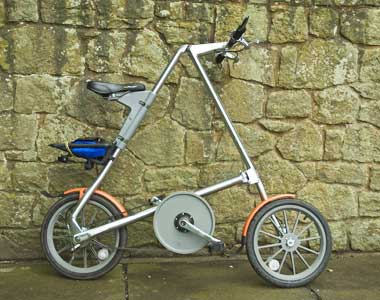
First published July 2007

12. Additional information from Mark Sanders
The Strida was designed by Mark Sanders in the mid 1980s; it was featured by the Design Centre in London, and won awards at the 1988 Cyclex for best new machine, best British product and best in show. With its striking appearance, it gained a great deal of publicity. Although some 25000 Stridas were made between 1987 and 1992 (ref: "It's in the bag!"), the company closed in 1992 after being over-ambitious in its rate of expansion, and running out of cash - with outstanding orders for 2,000+ Stridas. However, as with some other folders, the design was resurrected some years later, and the Strida has been back in production for a few years now. The basic design is unchanged, but incorporates many improvements. The most visible difference between the current Strida 3 and the original 1980's Strida is that the all-black finish has been replaced with a polished aluminium colour for the frame.
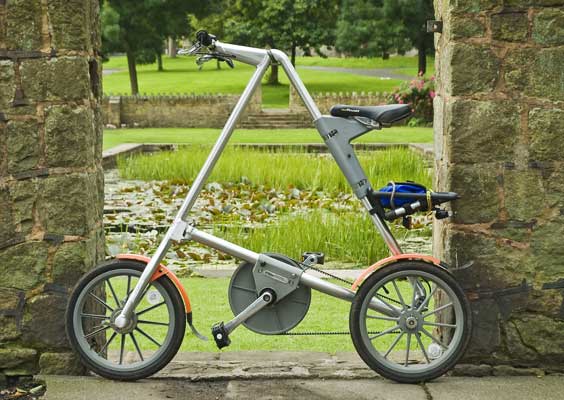
The triangluar (A-shaped) frame of the Strida was for many years unique, and it is only recently with the Sinclair A-Bike that it has appeared elsewhere. It is primarily a short distance commuting machine, and most aspects of the design are focussed on this role. Only a single gear is used, and belt drive is used so that the usual problems of oily chains can be avoided - belt drives are less efficient than chains (designer Mark Sanders has comments on this assertion though, see the end of this report), but this is not particularly important for short-distance commuting, whereas arriving at work without getting oily is important. Most folder owners will at some time have got chain oil on their hands or clothing when folding or carrying the machine, and will understand the benefits of a belt drive, at least for short distance commuting. The 16 inch wheels are the 305 version, which is substantially smaller in diameter than the 349 16 inch wheel used by many other folders; this helps to keep the machine compact when folded, without having too much impact on the rolling resistance. Tyre choice in this size is more limited than for the 349 version of 16 inch wheel (at least in terms of high performance tyres), and the use of plastic wheels places limits on tyre pressure - more of this later. When folded, the machine becomes a long, narrow package - not especially compact, but fairly easy to store, and it has the advantage that when folded the bike can be pushed along on its wheels, so there is no need to lift it except when going up or down stairs.
Although the original Stridas have been out of production for some years, the current Strida operation can still supply many parts for them, and support for owners of the old machines by the current organisation is reported to be very good. Owners of current Stridas also report very good support from the company.
Early in 2007 the Strida 5 was announced. This is available now in some parts of the world, but not yet (July 2007) in the UK. The most obvious differences seem to be that disc brakes are now used in place of drums (the drum brakes seemed more than adequate, so perhaps this is either a question of availability or of fashion), and changes to the bottom bracket/'chainwheel' - apparently the novel arrangement whereby the freewheel was in the bottom bracket has been abandoned and the freewheel is now in the rear hub, in the convenional way.
The bike tested is a Strida 3 from early in 2006 - it has taken rather a long time to get around to doing this report!
Construction of the Strida is almost entirely aluminium and plastic, the main frame tubes being aluminium and many of the fittings plastic (grey, black or coloured). There is no suspension.
The saddle mounts on a plastic bracket direct to the rear frame tube. Height adjustment is rather more awkward than on a conventional bike with a seat post, and would make sharing of a single bike by people of significantly different height rather difficult. Raising the saddle brings the rider closer to the handlebars, which is really the reverse of what one would normally want, but in any case the riding position is not entirely conventional, and for the shorter distances for which the Strida is intended, it is not as much of a problem as one might expect. Because you cannot step forward over a top tube when stopping a Strida, it is essential to be able to comfortably place your feet on the ground while seated on the sadlle, so you will have the saddle much lower than on a conventional bike, where for efficiency the legs should be almost straight when riding with the pedal at its lowest position. This means that your legs will always be bent when riding, and, combined with a bottom bracket which is quite well forward, this gives an unusual riding position, which may cause comments from passing urchins (the unusual appearance of the bike would probably provoke that reaction anyway).
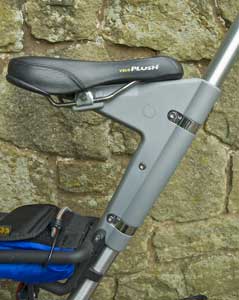 Saddle
height adjustment is not as simple as with bikes fitted with a
conventional seat post, but there is quite a lot of height adjustment
available. The saddle fitted to the bike in this picture is not
standard - I found the one supplied was too broad and soft for me. As
the picture shows, there is some fore and aft movement possible along
the saddle rails, so that I have positioned it a little way back from
the most forward position. The saddle angle cannot be adjusted, though
it is
unlikely you would want to.
Saddle
height adjustment is not as simple as with bikes fitted with a
conventional seat post, but there is quite a lot of height adjustment
available. The saddle fitted to the bike in this picture is not
standard - I found the one supplied was too broad and soft for me. As
the picture shows, there is some fore and aft movement possible along
the saddle rails, so that I have positioned it a little way back from
the most forward position. The saddle angle cannot be adjusted, though
it is
unlikely you would want to.
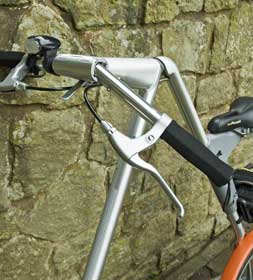 Handlebar
height is not
adjustable, and fore and aft adjustment of saddle position is limited.
The saddle fitted varies (the 'Performance Pack' machines
have a
'better' saddle) - I found the one included in the performance pack was
far too broad and soft, and fitted a
conventional saddle which was originally fitted to another bike
which had been upgraded to one of my preferred models. Personally I
found this narrower and harder
saddle a huge improvement, though no doubt it would not suit a lot of
people. On the original Strida, the inability to fold the handlebars in
any way meant that the width when
folded was a problem. On the Strida 3
the 'Performance Pack' incorporates handlebars which can be folded down
(on my bike
you flip a quick release, pull the ends of the bars outward,
fold them
down and then close the quick release; to unfold, release the QR, fold
the bars up, push them in, and while holding them in, lock the QR;
later machines incorporate a locking button on each bar end, so that
the bar is doubly locked in position for security, and which also means
that when the bars are pushed in, they lock automatically, so that they
do not need to be held in place while locking the QR).
Handlebar
height is not
adjustable, and fore and aft adjustment of saddle position is limited.
The saddle fitted varies (the 'Performance Pack' machines
have a
'better' saddle) - I found the one included in the performance pack was
far too broad and soft, and fitted a
conventional saddle which was originally fitted to another bike
which had been upgraded to one of my preferred models. Personally I
found this narrower and harder
saddle a huge improvement, though no doubt it would not suit a lot of
people. On the original Strida, the inability to fold the handlebars in
any way meant that the width when
folded was a problem. On the Strida 3
the 'Performance Pack' incorporates handlebars which can be folded down
(on my bike
you flip a quick release, pull the ends of the bars outward,
fold them
down and then close the quick release; to unfold, release the QR, fold
the bars up, push them in, and while holding them in, lock the QR;
later machines incorporate a locking button on each bar end, so that
the bar is doubly locked in position for security, and which also means
that when the bars are pushed in, they lock automatically, so that they
do not need to be held in place while locking the QR).
The
photograph shows one end of the handlebars partly folded down -
pictures showing the bars fully folded can be found in the section on
folding and unfolding.
Both the front and the back wheels are supported by single forks on one side (the left at the front and right at the rear). One of the advantages of this design is that tyres and tubes can be removed when mending punctures without the need to take off the wheel.
Mudguards and the small plastic rear carrier are part of the optional extra 'Performance Kit', and do not come with the standard bike.
The frame is very solidy made, and feels extremley rigid. It is probably not the sort of machine which would be ridden very vigorously anyway, but certainly in normal use I have not detected any sign of flexing. Perhaps for this reason, although it is a fairly light machine in folder terms, the weight is rather greater than one might expect at first glance - the total weight is claimed to be 10Kg (22 lbs).The Strida has only a single gear, which is quoted as being 56 inches. Given the unique design of the machine and the use of a belt drive, there is no possibility of fitting any multiple gear sustem, nor would it be easy to find alternative parts to allow raising or lowering the gearing. In practice I found the gearing to be quite well chosen for the intended use. I can normally get up most moderate hills without too much difficulty - but you have to do so at your own pace, which means that if you are balked by other riders or traffic you cannot easily slow down. It is not practical or safe to get out of the saddle and stand on the pedals as you can with a conventional bike on a hill. A recent evening visit to Dudley Castle (in the grounds of Dudley Zoo), which is at the top of a hill, did defeat me, and I had to dismount and push for a short distance.
With the lowish single gear, riding on the flat or gentle descents can be a bit frustrating, you just have to settle for making steady, but not especially fast, progress. On steeper descents you can of course just let the bike coast, which it does reasonably freely, and as the brakes perform well, a decent speed can be achieved. On my machine the belt is inclined to rub against the side of the 'chainring', producing a slightly irritating creaking noise, and attempts to move the belt to a more central position haven't been successful - it just moves back to the side and rubs again. When freewheeling it is slightly odd to see the belt and 'chainring' rotating - the freewheel is in the bottom bracket rather than the rear hub - but there are no real disadvantages to this. I believe that the new Strida 5 has reverted to the more normal system of having the freewheel in the rear hub.
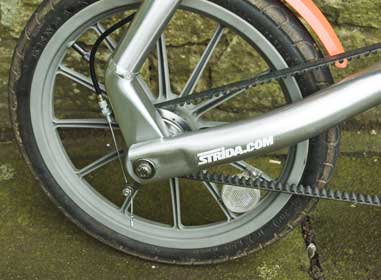
The belt drive to the rear wheel, showing also the rear drum brake cable (concealed in the rear frame tube). Later bikes have a new 'snubber', which helps to avoid any possibility of belt slip, while allowing slightly lower tension of the belt, which improves efficiency. On the bike tested, without the snubber, the belt has only slipped one notch once - but I'm not a strong rider.
Prior to the announcement of the Strida 5, all Stridas used drum brakes. Those on my machine are excellent - I haven't tried an Alpine decent, but that is hardly what this bike is intended for. The Strida 5 now has disc brakes - these may be fashionable and look good, but I really don't think that they are necessary on the Strida. The brake levers are comfortable and effective, with no flex, and can be adjusted for reach. Loops in the handelbar end caps can be used to hold the levers in, providing a parking brake.
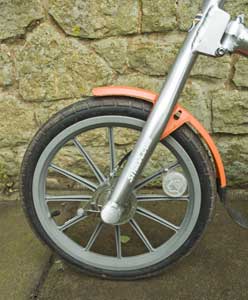
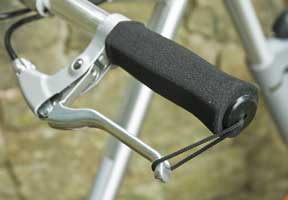
Cable to the front brake is concealed inside the front tube. Not visible at this magnification, but the plating on the drum brake assembly is showing some corrosion after 18 months of light use - most of the bike is aluminium or plastic, so only a few parts like this are susceptible. On the right, the loop in the handlebar end cap serves as a parking brake. Both end caps are so equipped, but I have a mirror mounted on the right, so only the left hand one is available on my bike.
The Strida 3 is equipped with plastic wheels as standard, though conventional spoked wheels are an optional extra (standard I believe on the Strida 5). The plastic wheels do limit the pressure than can safely be put in the tyres, but in practice most tyres of this size are not rated for high pressure anyway, and the small, unsuspended wheels mean that for reasons of comfort one would not want to use high pressure tyres on this bike.
My bike was fitted with Kenda tyres, and these seem to roll reasonably freely even at modest pressure of 40-50psi. They seem to grip adequately for a bike of this type, and have some tread. So far I have not experienced any punctures (the single-sided forks mean that removal of a tyre or tube is very straightforward). While I would not choose to take this bike off road, I have been on a couple of organised rides which forced me to do this, and it coped surprisingly well, though inevitable the small wheels and lack of gears presented problems, especially on coarse gravel. Availability of tyres and tubes of this size is limited in the UK, and it would be wise to carry, or at least have in stock at home, a spare tube. The tubes are fitted with Schraeder valves - probably a sensible choice for this machine, at least when fitted with quite low pressure tyres.
The main components on the bike seem of quite good quality, though after 18 months my bike has some corrosion of the few plated components. Mudguards and a rack are not fitted as standard, and the standard model does not have the folding pedals nor the folding handlebars. All of these are in my opinion very useful or even essential - the handlebars in particular make the machine far smaller when folded, and the folding version could not be retrofitted to a bike not so eqipped originally - so I strongly recommend buying the bike with the 'performance kit'.
The extras for this bike come as a 'performance kit', which at the time of writing adds £85 to the price. The kit consists of mudguards, folding handlebars, folding pedals, a rear rack and 'velo super-plush gel saddle'. Although described as a 'kit', at least some of these items will probably be fitted when the bike is purchased (the handlebars, for example, are an integral part of the machine).
For use in the UK, mudguards are really an essential, but they are an extra - part of the 'performance kit'; if you have the pack, you get 3 pairs of mudguards in different colours (orange, green and blue), so that you can colour code your bike to your choice - or even change it if you wish (rather like my Smart, for which you can change the coloured body panels, but at a much higher cost!). The mudguards are fairly small, but are adeqate for the sort of use to which the Strida is likely to be put; they incorporate mud flaps.
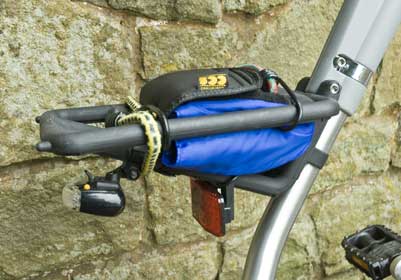 The
luggage rack is a small
plastic device, which the specification rates as being able
to holds 30 lbs (14kg). I will take their word for that -
personally I would not want to put half that amount on it! However, it
is quite adequate for a small bag containing tools and a waterproof
etc, as the photograph shows (the bag etc do not come with the bike,
but a multiple function allen key is supplied, as is a tiny one for
adjusting the locking force which holds the bike in a folded position).
The
luggage rack is a small
plastic device, which the specification rates as being able
to holds 30 lbs (14kg). I will take their word for that -
personally I would not want to put half that amount on it! However, it
is quite adequate for a small bag containing tools and a waterproof
etc, as the photograph shows (the bag etc do not come with the bike,
but a multiple function allen key is supplied, as is a tiny one for
adjusting the locking force which holds the bike in a folded position).
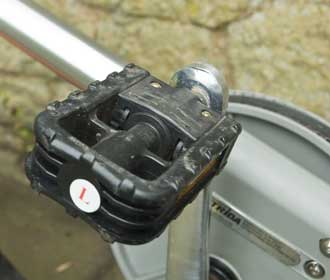 The folding
pedals are much
what you would expect - push in on the ends and fold them up when
folding, simply fold them down and they spring out and lock positively
in position when unfolding. They are useful, if not essential, to
reduce the size of the machine when folded.
The folding
pedals are much
what you would expect - push in on the ends and fold them up when
folding, simply fold them down and they spring out and lock positively
in position when unfolding. They are useful, if not essential, to
reduce the size of the machine when folded.
The most essential feature of the performance kit is the folding handlebars. These have been described in detail elsewhere in this report, and drastically reduce the size of the folded machine - with fixed bars it is quite bulky. The folding bars are also very useful if you just want to lean the unfolded bike in a passageway - fold the bars and pedals down and the narrow machine is no longer an obstacle. To repeat what I have said earlier, to my mind the performance kit is essential.
The dimensions quoted for the folded Strida are: Standard: 45" x 20" x 20" (114cm x 51cm x 51cm), or with the performance kit: 45" x 20" x 9" (114cm x 51cm x 23cm)
The big difference in the figures is down to the folding handlebars, which is the reason I would strongly advise buying the bike with the kit (remember you cannot retro-fit the folding bars if you buy the standard machine).

Folding is very straightforward - visit the Strida web site at http://www.strida.co.uk to see a demonstration. Basically all you have to do is release the catch at the front of the bottom tube above the front wheel, drop the horizontal tube on the ground, pivot the front tube around it and backwards so that the front wheel is aligned with the back wheel, and press the two together - a magentic catch holds them in place. Then swing the bottom tube up alongside the right of the other tubes, where it clicks into place. Fold the handlebars and pedals in (assuming you have the performance kit). The bike stays firmly latched together as a single unit, and can be wheeled along on the road wheels - lifting is only necessary for steps. Unfolding is simply the reverse of the above process. For storage, you can lie the folded bike horizontally, supported on the wheels and rear carrier, or it can be stood vertically on the wheels, with the carrier resting against a wall - the small loops fitted in the handlebar end caps can be pulled around the brake levers to apply the brakes and prevent the wheels turning when storing in this position,as well as acting as a parking brake.
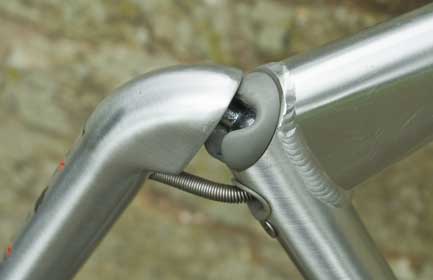
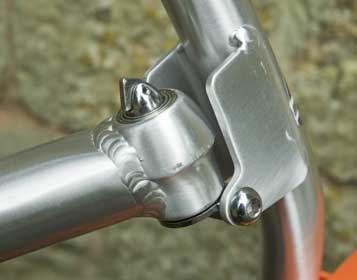
Left: The pivot at the top of the frame, allowing the handlebars to be turned, and the bike to be folded; the rear brake cable, which is concealed in the frame tubes, can also be seen. Right: The lower pivot - to fold the bike, the small latch at the top is pressed, and the bottom tube can then be lifted off.
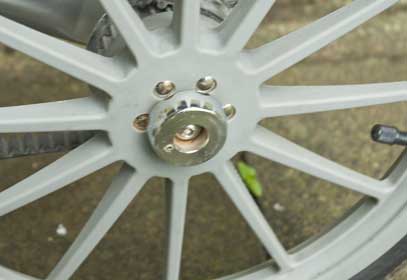 A
magnet holds the two wheels together when the bike is folded. The small
grub scre can be adjusted to increase or reduce the locking force, and
a suitable allen key for adjustment is supplied with the bike. Again
after 18 months there are some signs of corrosion on the plated parts
here.
A
magnet holds the two wheels together when the bike is folded. The small
grub scre can be adjusted to increase or reduce the locking force, and
a suitable allen key for adjustment is supplied with the bike. Again
after 18 months there are some signs of corrosion on the plated parts
here.
On a wet day, or if you have ridden through dirty conditions, holding the frame to fold the bike could mean getting your hands dirty, but otherwise, especially as there is a belt drive and no oily parts, folding and unfolding should be a clean job - probably the best folder available in this respect.
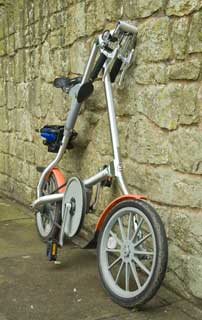 Another
option, particularly convenient if you
just want to store the bike in a corridor temporarily, and assuming you
have the 'Performance Pack', is just to fold the handlebars down and
fold the pedals.
Another
option, particularly convenient if you
just want to store the bike in a corridor temporarily, and assuming you
have the 'Performance Pack', is just to fold the handlebars down and
fold the pedals.
I approached riding the Strida with some trepidation - only 1 gear, and a very odd riding position. It was the riding position which gave me the most problems - initially I had not appreciated the strangeness of how you get on and off. On a conventional bike, including all other folders, you can stand over a top tube, push off, and then sit on the saddle, reversing the process when stopping. On such a bike, it isn't necessary (or desirable) to sit on the saddle with your feet on the ground - for efficient pedalling, the leg should be almost straight when the pedal is at its lowest point, which means you can't reach the ground with your feet while seated, you have to straddle the top tube. This is NOT true of the Strida - the A-frame means you cannot move forward to straddle the non-existent top tube - if you try to, it is very painful. So you must be able to put your feet on the ground comfortably while seated on the saddle, allowing for unhelful road camber too. This means an unusually low saddle, and bent legs when pedalling. The bottom bracket is also quite far forward, which adds to the cycling chimp appearance and feeling. Raising and lowering the saddle is a bit awkward (no quick releases here!), and if you do raise the saddle, you get nearer to the bars, which is really the opposite of what you would want. Whether you can get on with the riding position depends on your willingness to experiment, to accept something different from what you are used to, and may well depend on your size - I can only report on how I find it (5ft 7in, rather short in the leg). It took me a while to get to grips with the settings and the riding position - initially I tried to get the saddle height to pedal distance as near to normal as possible, but I realised in due course that the critical thing is being able to recah the ground with your feet - you will have to pedal with bent legs, and get used to it, and indeed I did.
Once underway, stability is quite good, but getting started does seem to provoke a combination of both over- and under- steer. I'm inclined to wobble when getting started, and most others I seen seem to have this problem too - familiarity improves things though.
Once you have adapted to it, the unusual riding position becomes less noticeable, though if you ride other bikes as well, you need a few minutes to acclimatise when returning to the Strida.
In the absence of suspension, and with very small wheels, the ride is inevitably rather harsh.
For a weak rider like myself, the thought of having only one gear is frightening. Actually, though, the choice of that gear, at least for me and the terrain I ride in, is very good indeed. The hill to Dudley Castle in the grounds of the Zoo did defeat me, but I think that so far I've struggled up all the hills I've encountered without expiring - of course I don't use the Strida for long rides, or hilly ones, but the area where I live is far from flat. Flat and gentle down hill riding can be quite frustrating with the single gear, you just have to settle for making steady, not very fast, progress. On steeper descents of course you can just let the bike coast, and it does this well, without excess rolling resistance or any other losses. When I use the Strida for the occasional commute, the trip to Sandwell & Dudley Station (c 5 miles) seems interminable, although in practice it only takes 10-15% longer than on a bike with more gears.
I was very impressed a few years ago when Tony Hadland brought a Strida to one of our Origami rides - he didn't ride it himself, but had brought it for someone else to try. The person trying it completed the ride without any apparent problems, and tackled everything encountered, including some canal towpath, comfortably. I took my Strida for a 'Sunday Origami' Ride earlier this year (2007), some 40Km, and the only real problem was some very coarse gravel on a towpath (others found this hard too), though riding in a group with a single gear is awkward on hills, as you need to go at your own pace. Overall I was impressed by the way the Strida coped. On the June Origami Ride, again about 40Km, and some equally awkard riding conditions, there was a lady on a slightly newer Strida, and she and her Strida impressed everyone too.
Progress is commendable, but I'm quite surprised by some changes in the Strida 5 - for a bike of this kind, I consider the drum brakes of the Strida 3 to be excellent, and I really don't see the point of discs (other than for fashion/marketing reasons). I think that the main shortcomings of the Strida are really fundamental to the design and the priorities which were set in carrying out the design.
I've used my Strida almost entirely for short rides locally, some commutes (I work VERY part time, so not many of these), and, so far, one Sunday Origami. It's handled most of these better than I originally though it would. There is no way that I would attempt a really long ride on it, let alone an Audax, and I think that even Dave Minter will not attempt the Paris-Brest-Paris on one (he successfully did the 2003 PBP on a 2-speed 1964 Moulton!).
In terms of riding, I think that the biggest problem is being prepared to spend the time getting used to it - it is different, and to be honest, I don't think better, in terms of the riding experience, but if you adapt to it, and recognise its very real virtues, the Strida is a usfeul folder, especially for short journeys.
Folding is exteremely easy, and though not the most compact in terms of volume, the folded bike is very easy to deal with. In a really full train, standing room only, you can hold the folded Strida in a vertical position; if there is a bit more space, it will lie horizontally very conveniently. If you just want to store it in a corridor, or possibly in a train, you can fold the handlebars and pedals (assuming you have the performance kit), and it will cause almost no obstruction. The ability to roll the bike along easily on its road wheels when folded is a great benefit, and I really miss it now when I have to carry other folders.
With only a single gear, and a non-optimal riding position, the Strida is clearly designed primarily for short commutes, with support from trains, buses, cars etc for longer distances. In line with this role, it is easy to fold, reasonably compact when folded, easy to roll along on its wheels even when folded, and fairly light. It is substantially cheaper than something like a Brompton, but more expensive than some of the extremely basic (crude?) imports now on the market. The lack of gears and the riding position mean that it is quite constrained in terms of how it can be used - for other than the short commute it is going to be quite hard work. The appearance is striking - how you feel about that is up to you, but you risk being laughed at by the ignorant on almost any small wheeler, and sometimes the reaction is much more positive (it created a very positive reaction when I went into the Apple shop in Birmingham, for instance). I started riding Moultons in 1964, so I'm largely immune by now to the attitude of those who laugh at anything unusual.
At £250, the Strida seems reasonably priced, but the Performance Kit adds another £85, and I think most owners would be very strongly advised to go for this, as folding handlbars in particular really are essential, and most of the other items in it are highly desirable. At £335 it is certainly cheaper than many good quality folders, but of course it is more limited than such machines as well.
Given the rather special design of the Strida, and the fact that it is firmly aimed at short distance commuting, there are few other folders with which it is sensible to compare it. The most obvious contender would be the Sinclair A-Bike. The A-Bike is a bit cheaper, and is just about unbeatable in terms of folded size and weight. However, the tiny wheels, high rolling resistance and drag, and more flexible frame mean that the A-Bike is substantially more limited than the Strida for riding. Unless the folded size and weight are absolutely essential, the Strida is certainly far better.
For many years I was rather dismissive of the Strida - wonderful for hanging on a wall as a piece of art, but terribly limited as a bicycle. Nevertheless, I always felt that I should give it a fair trial - opinions based on something you have not tried should be treated with caution. Eventually the enthusiasm of Chop Rossiter tipped me over the edge, and I bought mine early in 2006, and although I don't use it all that much (hence the delay in this report), I must say that it performs much better than I had expected. It is certainly well made, the Strida UK organisation is very good, designer Mark Sanders still takes a keen interest, and although the single gear and the riding position are limiting, you can do much more with it than you might expect. It's not the best machine for most potential folder owners, but it is better and more versatile than you might initially think, so if you want a compact folder for short journeys, do consider it.
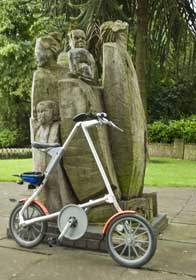
Strida (UK) Limited, 5 Lockhart
Drive, Sutton Coldfield, B75 6RR, United Kingdom.
Tel: 0845 002 0190
Web: http://www.strida.co.uk
Stridas are available from some retail outlets, or direct from Strida - UK web site at http://www.strida.co.uk
We sent a copy of this test report to Mark Sanders, the designer of the Strida, to see if there were any factual errors, and any comments he wished to add. Mark is still involved with the Strida, as well as his new design, the Swivel Head, both of which are manufactured by Ming Cycle. He sent us a very detailed reply, and we decided it was best to reproduce it with only a few edits, as the information he provides is most interesting. We would like to thank Mark for this useful input.
There is much discussion of the
efficiency of synchronous belts -
much is subjective (and cynical :-)). Gates,
the
makers and developers of HTD and synchronous belts most suitable for
bikes, are keen to get more facts about belt efficiency
'out-there'. They tell me they are about to do a big campaign
in
the bike world to showcase the benefits of belts for bikes. They
cite that these new belts are being used to replace chains in
industrial applications as part of government energy saving
initiatives. The simple analogy I use to show the efficiency of modern
HTD profiled toothed belts (c 96%) used on
bikes compared to well oiled, in-line chains (c 98%), is that
when
a hub gear
is used in a non-direct ratio, the efficiency of said chain drive drops
below that of the belt drive. The same is true when a
deraillieur is (incorrectly) used, say big chain wheel to
largest
(lowest gear)
rear sprocket on a 27 speed system - with all that gnashing of the
sides of teeth!
On a Strida, for minimum drag / maximum efficiency of the belt, I
advise
riders to adjust and use it on minimum tension you can manage, before
you get tooth jump. This varies depending on your weight and usage (eg
fast take offs need more belt tension). I am very pleased with our new
snubber system (ie the bearing near the belt at the back). This bearing
normally does not touch the belt so adds no friction. But at times of
extreme force (eg setting off hard) it prevents the teeth coming out of
engagement with the rear pulley. This means the belt drive can run at
minimal tension, ie maximum efficiency for most of the time. Even when
the belt pushes against the snubber bearing, as it is a precision
bearing, the friction increase is marginal. The pages from Strida
service site on belt
and snubber
adjustments can be found HERE.
Other tips, comments and factoids are HERE.
Strida (and car
camshaft belts) are reinforced with Kevlar
for super strength. However Kevlar is a weird material with a reverse
co-efficient of thermal expansion (ie unlike most materials, it gets
longer as it gets colder and vice versa). In the early days of the
Strida I didn't realise this - so in the winter when
I was
testing early belt systems I'd set up the tension perfectly (in the
warm workshop), but when testing it seemed to get loose, back in
workshop it was OK .... It took a lot of head scratching to
work
this out :-).
Lotus Cars first introduced a snubber in the 1970's, when they were
developing their first belt drive camshaft engines ... which used to
jump in cold Canadian mornings - and wreck the engines ... but their
snubber was crude at that time - it did not have bearings and
just forced the belt to stay engaged. Snubbers, especially
with
bearings, are very neat because they do not touch the belt in normal
use, only when the belt is about to slip - they allow the
belt
tension to be reduced and so improve efficiency and wear.
The Strida 5 has the freewheel at the back, but any savings
due to
the belt not turning when freewheeling are offset by the 1:3 ratio
turning the front freewheel - lost when it is at the back. This change
was more due to being able to use the now more available disc brakes
(cf drums), and a conventional crank. All this was made possible by the
neat wheel hubs Ming developed for the Strida 5, and light spoked
wheels. Unlike me, they never appreciated the 'bomb-proof'
plastic wheels and drums. (The Strida 5 will need more protection when
using on airlines).
Overall the Strida 5 gives slightly more performance due to metal rims
and high pressure tyres - the wheels, disc brakes are awesome, and look
cool (bling?), but the drums are OK too. I've got all Stridas and my
personal bike is a 3 for its abuse resistance !
To be fair, I have problems at the other extreme to you (and to my wife), that is, knee clearance [For those who have not met him, Mark is tall - Ed]. Setting up a Strida for each individual's reach, stretch comfort and to match other preferred riding position is a challenge, more so at either extreme - and more so if a more sporty, lean forward position is preferred.
My wife only uses a Strida (a high-mileage daily commuter - she works as a consultant Pharmacist, so needs to get about when traffic is slow). She is used to its upright, get on from back 'weirdness' and now prefers it. I Jump from bike to bike so I can understand your point more clearly.
Ming are looking at the possibility of making a smaller framed Strida (as well as the standard size). This is in response to similar requests from their biggest markets in the far east.
For tall riders - it is best to
put saddle as far back on its rails
as it will go. This is a good riding position for round town - good
visibility, straight back, bent arms - little jolt through the
bars/arms. To lean forward in a sporty position, bend the
arms,
but the Strida was not designed for speed :-). I have set my bike (as
in notes) with the top of seat as high as possible, ie 40 inches, which
gives
full leg stretch, this also gives more knee clearance. This is
because the handlebars are so high, so that at full leg stretch, the
knee clearance increases as saddle goes up !! (opposite to
most
people's expectations).
The Strida is a BIG seller in Taiwan, Japan, Singapore and especially South Korea, where it its the top selling folding bike of all. Strida.co.kr sell 5000 Stridas a year (they also sell Brompton and Cannondale); total Strida sales now over 20,000 globally. Due to the majority of sales going to local markets in the far east, Ming often tweak the design for these markets (eg adding extra side stands etc.). This also has moved the smaller size Strida development up the priorities.
I have made a selection of personal tips and comments about the Strida for owners. It is on the Strida Service site, viewable and for download, HERE.
Test reports | Folding Society home page | Strida UK home page